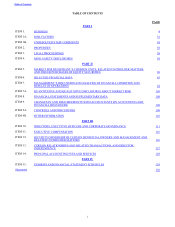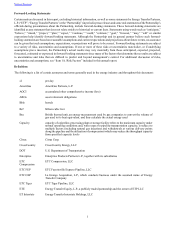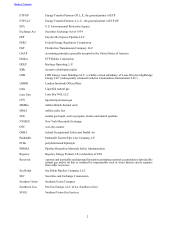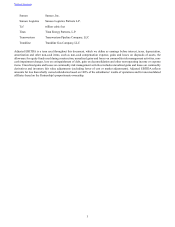Energy Transfer 2012 Annual Report Download - page 16
Download and view the complete annual report
Please find page 16 of the 2012 Energy Transfer annual report below. You can navigate through the pages in the report by either clicking on the pages listed below, or by using the keyword search tool below to find specific information within the annual report.
8
transportation pipeline for a specified period of time and which obligates the customer to pay even if the customer does not transport
natural gas on the respective pipeline, (ii) a transportation fee, which is based on the actual throughput of natural gas by the
customer, (iii) fuel retention based on a percentage of gas transported on the pipeline, or (iv) a combination of the three, generally
payable monthly.
We also generate revenues and margin from the sale of natural gas to electric utilities, independent power plants, local distribution
companies, industrial end-users and other marketing companies on our HPL System. Generally, we purchase natural gas from
either the market (including purchases from our midstream segment’s marketing operations) or from producers at the wellhead.
To the extent the natural gas comes from producers, it is primarily purchased at a discount to a specified market price and typically
resold to customers based on an index price. In addition, our intrastate transportation and storage segment generates revenues from
fees charged for storing customers’ working natural gas in our storage facilities and from margin from managing natural gas for
our own account. The major customers on our intrastate pipelines include Kinder Morgan, Natural Gas Exchange, Inc., XTO
Energy, Inc., Total Gas & Power North America and EDF Trading North America, Inc.
Interstate Transportation and Storage Segment
Natural gas transportation pipelines receive natural gas from other mainline transportation pipelines and gathering systems and
deliver the natural gas to industrial end-users, utilities and other pipelines. Through our interstate transportation and storage
segment, we directly own and operate approximately 12,600 miles of interstate natural gas pipeline and have a 50% interest in
the joint venture that owns the 185-mile Fayetteville Express pipeline. ETP also owns a 50% interest in Citrus which owns 100%
of FGT, an approximately 5,400 mile pipeline system that extends from south Texas through the Gulf Coast to south Florida.
Our interstate transportation and storage segment includes Panhandle, a wholly owned subsidiary of Southern Union, which is
owned by Holdco. Panhandle owns and operates a large natural gas open-access interstate pipeline network. The pipeline network,
consisting of the PEPL, Trunkline and Sea Robin transmission systems, serves customers in the Midwest, Gulf Coast and
Midcontinent United States with a comprehensive array of transportation and storage services. In connection with its natural gas
pipeline transmission and storage systems, Panhandle has five natural gas storage fields located in Illinois, Kansas, Louisiana,
Michigan and Oklahoma. Southwest Gas operates four of these fields and Trunkline operates one. Through Trunkline LNG,
Panhandle owns and operates an LNG terminal in Lake Charles, Louisiana.
The results from our interstate transportation and storage segment are primarily derived from the fees we earn from natural gas
transportation and storage services. The major customers on our interstate pipelines include Chesapeake Energy Marketing, Inc.,
EnCana Marketing (USA), Inc. (“EnCana”), Shell Energy North America (US), L.P., BG LNG Services, ProLiance Energy, LLC
and Petrohawk Energy Corporation.
Midstream Segment
The midstream natural gas industry is the link between the exploration and production of natural gas and the delivery of its
components to end-use markets. The midstream industry consists of natural gas gathering, compression, treating, processing and
transportation, and is generally characterized by regional competition based on the proximity of gathering systems and processing
plants to natural gas producing wells.
The natural gas gathering process begins with the drilling of wells into gas-bearing rock formations. Once a well has been completed,
the well is connected to a gathering system. Gathering systems generally consist of a network of small diameter pipelines and, if
necessary, compression systems, that collect natural gas from points near producing wells and transports it to larger pipelines for
further transportation.
Gathering systems are operated at design pressures that will maximize the total throughput from all connected wells. Specifically,
lower pressure gathering systems allow wells, which produce at progressively lower field pressures as they age, to remain connected
to gathering systems and to continue to produce for longer periods of time. As the pressure of a well declines, it becomes increasingly
difficult to deliver the remaining production in the ground against a higher pressure that exists in the connecting gathering system.
Field compression is typically used to lower the pressure of a gathering system. If field compression is not installed, then the
remaining production in the ground will not be produced because it cannot overcome the higher gathering system pressure. In
contrast, if field compression is installed, then a well can continue delivering production that otherwise might not be produced.
Natural gas has a varied composition depending on the field, the formation and the reservoir from which it is produced. Natural
gas from certain formations is higher in carbon dioxide, hydrogen sulfide or certain other contaminants. Treating plants remove
carbon dioxide and hydrogen sulfide from natural gas to ensure that it meets pipeline quality specifications.
Some natural gas produced by a well does not meet the pipeline quality specifications established by downstream pipelines or is
not suitable for commercial use and must be processed to remove the mixed NGL stream. In addition, some natural gas produced
Table of Contents
























